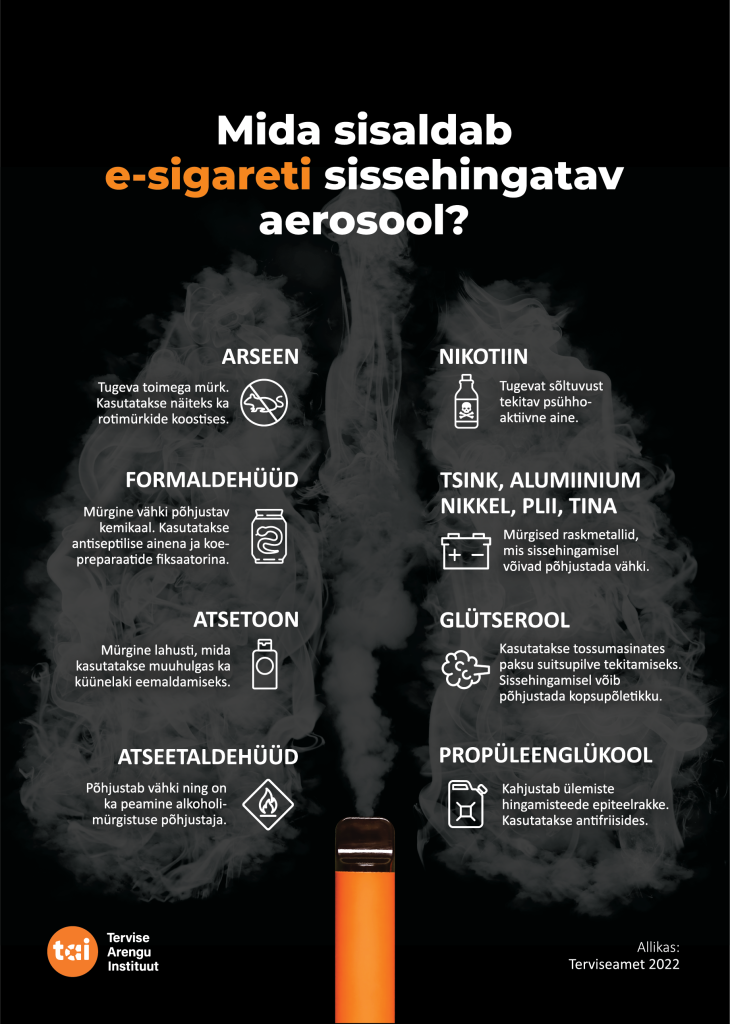As smoking regular cigarettes has become less popular, many alternative tobacco products have been quickly brought to market in order to continue benefiting from people’s addiction.
With new products there comes a lack of knowledge and misinformation, so people do not know to be wary of them. Anna-Liis Veerpalu, senior specialist of alcohol and tobacco at the National Institute for Health Development debunks the most common myths.
Myth: E-cigarettes (ie vapes) and snus are good alternatives to giving up cigarettes.
Truth: It does not matter how it is consumed, nicotine is harmful for health.
Nicotine is a strong neurotoxin that causes addiction typical to narcotic substances. Compared to cigarette smokers, users of vapes may unknowingly consume even more nicotine, as a vape lasts longer than a regular cigarette. While one cigarette contains up to 1 mg of nicotine, one millilitre of e-liquid contains up to 20 mg of nicotine.
Compared to smoking, the risk of becoming addicted to nicotine is 2–4 times higher when using snus. As snus is in constant contact with the mucous membrane, nicotine remains in the human body longer and its levels are more consistent compared to smoking regular cigarettes. It is also likely that it causes more nicotine to enter your body. The younger you start using snus, the faster and stronger you develop nicotine addiction and the harder it is to quit. Therefore, by substituting regular cigarettes for vaping or snus, you are simply replacing one health-harming habit with another.
Myth: Using tobacco or nicotine products calms the mind and relieves stress.
Truth: Nicotine actually stimulates the nervous system and increases your stress levels.
Nicotine is a stimulant that stimulates the nervous system and the activity of the entire body, thus making you more anxious. Using nicotine damages the central nervous system and may cause anxiety, and attention and concentration disorders. Nicotine is particularly dangerous for young people, as the human brain develops until the age of 26 and nicotine affects the part of brain responsible for attention, memory, learning, mood and impulse control. Quitting nicotine significantly improves brain function and increases alertness and concentration. It also improves memory and eliminates headaches that interfere with thinking.

Myth: Vaping is harmless because you only inhale vapour.
Truth: Vapes contain a variety of health-harming toxic substances.
Vapes heat up liquid whose aerosol the user then inhales through the mouth. Similarly to regular cigarettes, vapes contain health-harming substances and can cause various health problems. E-liquids may or may not contain nicotine. E-liquids that contain nicotine are dangerous, as nicotine itself is an addictive neurotoxin.
However, even nicotine-free vapes are not harmless. The aerosol you inhale when vaping contains, for example, glycerol, propylene glycol, formaldehyde, acetaldehyde, arsenic and acetone. These chemicals are also used in the chemical, food and textile industry. They are dangerous substances that can cause poisoning and malignant tumours if inhaled.
In addition, vape aerosol contains heavy metals such as lead, zinc, aluminium, nickel and tin, which are also harmful if inhaled and may cause cancer. The flavourings used in e-liquids are also toxic and may damage the heart and cells in the blood vessels.
Myth: Vaping does not affect bystanders.
Truth: Vaping also harms bystanders who inhale the aerosol exhaled by vape users.
Research shows that the aerosol exhaled during vaping contains a variety of toxic substances and nicotine. Vape aerosol has been found to contain fine particles of metals such as iron, silver, tin, nickel, aluminium, copper, lead and chromium. This makes even passive vaping dangerous.
Both smoking and vaping release harmful substances into the environment. Therefore, the risk to bystanders is not limited only to substances they inhale directly, but continues as the substances are deposited in the environment.
Do not be fooled! What do these boastful words actually mean?
Manufacturers of alternative tobacco and nicotine products often advertise themselves, using buzzwords like ‘smokeless’ and ‘tobacco free’, hoping to give the impression that the products are significantly healthier than cigarettes. In reality, all these products contain harmful substances better to be avoided altogether.
Smokeless products. These are non-combusted tobacco products, such as chewing tobacco, snuff and snus. Smokeless tobacco products contain nicotine, which causes a hard-to-kick addiction. Smokeless tobacco products are classified as carcinogenic, ie products that cause cancer, and are known to contain 28 carcinogens.
Tobacco-free products. These are products like vapes and nicotine pouches, which do not contain tobacco, but may contain nicotine. A nicotine pouch, also known as snus, is a little sachet of nicotine, cellulose, flavourings and parabens, which is placed under the lip. From there, nicotine is absorbed through the gums into the bloodstream. Nicotine is a neurotoxin that harms health. In addition, using nicotine pouches causes oral mucosa damage such as inflammation and gum disease.
An e-cigarette, or vape, is a battery-powered device that heats a liquid whose aerosol the user then inhales through the mouth. Vapes use both nicotine and nicotine-free liquids, which contain toxic subst
The article was written by the National Institute for Health Development.







